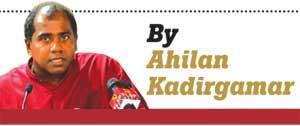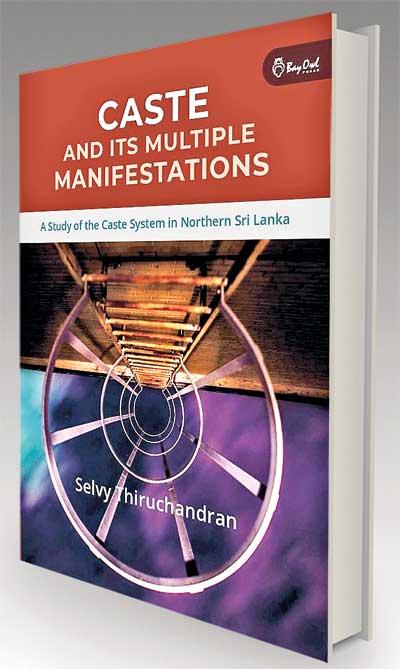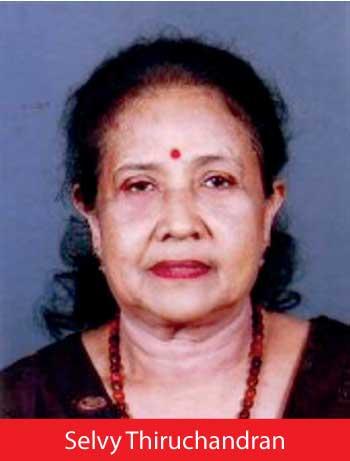Reply To:
Name - Reply Comment
Last Updated : 2024-04-23 14:45:00
A Review of ‘Caste and its Multiple Manifestations: A Study of the Caste System in Northern Sri Lanka’ by Selvy Thiruchandran, Bay Owl Press 2021.
The persistence of caste has been a preoccupation of many scholars of South Asia. How does the caste system continue despite centuries of colonialism, the capitalist economy, the modern state with its various institutions and the recent decades of neoliberal globalisation?
modern state with its various institutions and the recent decades of neoliberal globalisation?
Caste works in different ways depending on place and time. In post-war Northern Sri Lanka, caste relations have been changing and consolidating through stealth. Amidst such dynamics there is a dearth of scholarship on caste, characteristic of the silencing of discussions on caste in the contemporary North.
In this context, Selvy Thiruchandran’s new book ‘Caste and its Multiple Manifestations: A Study of the Caste System in Northern Sri Lanka’ is a welcome contribution to reviving the debate on caste in the North. In looking at the multiple manifestations of caste, Thiruchandran uses multi-faceted methods and sources, from historical writings, field research, literary sources and her own engagement over the decades as an advocate for women’s rights and social justice.
"Over the last one hundred years, at every historical turn and change in the North, caste cannot be avoided; caste is present either as overt struggles or as conscious silencing measures"
There have been a few recent works in Tamil about caste in the North. Significant among these books is the recent republication of the updated third edition of ‘Ilangaiyil Sathiyamum Atthakethirana Porattangkalum (The Struggles against Casteism in Sri Lanka)’ by Vekujanan (S. K. Senthivel) and Iravana (N. Raveendran), a powerful work written by anti-caste leftist activists. However, Thiruchandran’s work stands out as the first comprehensive work in English addressing caste in post-war Northern Sri Lanka; thus making the issue accessible to a Southern and international audience. Given that the Tamil elite, including the Tamil political establishment, have consistently suppressed public discussion of caste, Thiruchandran has shown tremendous intellectual courage in raising her voice to break this silence.
Historical landscape
 Northern Sri Lanka has gone through enormous changes with colonialism and over the last century in particular. The Dutch codification of customary Thesawalamai laws in the 18th century towards accumulation through caste relations of production, the impact of American missionaries on education in the early 19th century and the transformation of Hinduism in the latter part of the 19th Century provide the historical backdrop to the analysis in the book.
Northern Sri Lanka has gone through enormous changes with colonialism and over the last century in particular. The Dutch codification of customary Thesawalamai laws in the 18th century towards accumulation through caste relations of production, the impact of American missionaries on education in the early 19th century and the transformation of Hinduism in the latter part of the 19th Century provide the historical backdrop to the analysis in the book.
Thiruchandran’s critical evaluation of some of the prominent Jaffna Tamil leaders – who are the subjects of a contemporary cynical discourse within the Tamil community that seeks to deify them with selective amnesia – is a brave move on her part to set the historical record straight. The 19th Century Hindu revivalist Arumuga Navalar, the late colonial social reformer Ponnambalam Ramanathan and the Tamil political leader at the time of Independence G. G. Ponnambalam, and their complicity in reinforcing oppressive caste relations and attempts to exclude oppressed caste communities from education, suffrage and welfare services raise challenging historical questions for Tamil society.
Over the last one hundred years, at every historical turn and change in the North, caste cannot be avoided; caste is present either as overt struggles or as conscious silencing measures. In the 1920s, the Jaffna Youth Congress credited to be the first island-wide anti-colonial movement, took on the issue of caste including with practices of equal seating and common dining and then went on to invite and arrange Mahathma Gandhi’s visit to Jaffna greatly shaping the cultural history of the North. During the debates around universal suffrage in the late 1920s and then in the lead up to Independence in the 1940s, the Oppressed Tamil Workers’ Union and the Minority Tamils Mahasabha, both anti-caste movements of the oppressed communities, vocalised their demands for equality to colonial commissions despite considerable opposition from the Tamil elite.
"Thiruchandran had carried out field research in Jaffna, Mullaitivu and Vavuniya to understand the post-war dynamics of caste. She unsparingly records the many acts of discrimination in employment and education that have been conveyed to her"
The book provides an accessible summary of oppressed caste literary figures and their writings in the form of short stories and novels, which were both acts of resistance and providing crucial insights about the workings of caste. Joel Paul James, K. Daniel, Dominic Jeeva and N. K. Ragunathan, are some of those literary activists whose works form an important body of literature that reflect the historical undercurrent before the emergence of powerful anti-caste struggles.
Thiruchandran narrates the history of the major anti-caste struggles in the late 1960s, mobilised by the demands of temple entry and equal seating in tea shops, while drawing on the Social Disability Act of 1957. The subsequent eclipse of Tamil nationalism, the civil war and the reign of the LTTE begin the long silencing of caste in Jaffna. Given the many questions about the role of the LTTE in relation to caste, Thiruchandran has the following to say:
“If it is true that the LTTE took a firm stand officially against caste observances, it had its limitations in two important areas. It was mostly observed within their cadres and violators were punished severely. The message did not go deep down to the community at large for what is instituted at gunpoint does not last when the guns are removed. Their attempts were not accompanied by consciousness raising. … Their attempt was motivated by a political need to keep the cadres united and focused on a cause. Internal divisions among them, the leader thought, would weaken their struggle. They saw it as a political need to silence the issue of caste among them and avoid conflicts arising from caste belonging, in order to unite them all against the common enemy, the Sinhala state and the Sinhala community. After the regime of the LTTE, caste was supposed to have re-emerged among the same people. … Contrary to this, there are influential people, mainly politicians, who want to maintain a culture of silence by asserting that ‘when caste is not an issue why talk about it?’ which was their rhetorical question.”
punished severely. The message did not go deep down to the community at large for what is instituted at gunpoint does not last when the guns are removed. Their attempts were not accompanied by consciousness raising. … Their attempt was motivated by a political need to keep the cadres united and focused on a cause. Internal divisions among them, the leader thought, would weaken their struggle. They saw it as a political need to silence the issue of caste among them and avoid conflicts arising from caste belonging, in order to unite them all against the common enemy, the Sinhala state and the Sinhala community. After the regime of the LTTE, caste was supposed to have re-emerged among the same people. … Contrary to this, there are influential people, mainly politicians, who want to maintain a culture of silence by asserting that ‘when caste is not an issue why talk about it?’ which was their rhetorical question.”
I quote Thiruchandran at length here as these are points that should be debated extensively by Tamil intellectuals. Indeed, such debates are crucial for breaking the silence that is complicit in the new forms of caste oppression and exclusion.
Research and struggles
Thiruchandran had carried out field research in Jaffna, Mullaitivu and Vavuniya to understand the post-war dynamics of caste. She unsparingly records the many acts of discrimination in employment and education that have been conveyed to her. The predicament of youth who are forced to adhere to caste endogamy in marriage and even distancing in their socialisation, for example not visiting friends of other castes in their homes, are worrying trends. Such casteist forms of social exclusion may continue with the younger generations unless checked by progressive youth movements.
employment and education that have been conveyed to her. The predicament of youth who are forced to adhere to caste endogamy in marriage and even distancing in their socialisation, for example not visiting friends of other castes in their homes, are worrying trends. Such casteist forms of social exclusion may continue with the younger generations unless checked by progressive youth movements.
The book touches upon and opens up many questions that future research on caste in the North needs to explore. Thiruchandran addresses how gender intersects with caste, as the control over the bodies and behaviour of oppressed caste women relate to the deployment of patriarchal upper caste power. Indian social scientist M. N. Srinivas’ theorisation of Sanskritisation, relates to the recent investment in temples as well as rebuilding many of them as agamic institutions. Similarly Andre Beteille’s work on caste labour unions, relate to the changes in caste occupations that have emerged, for example the formalised institutions of barbers and toddy tappers. The role of landlessness and landed relations in the persistence of caste oppression requires considerable political economic research.
While research and writings need to reflect on the contemporary character of the abominable caste system, the silence on caste is breaking with struggles and resistance of oppressed caste communities. Few years ago a number of struggles around cemetery lands, where upper castes sought to reinstitute cremations in long abandoned cemeteries adjacent to oppressed caste dwellings, led to major confrontations. Those struggles were reflected in increasing oppressed caste representation through the local government elections of 2018. Few months ago a violent incident of an oppressed caste man being slashed and the neighbouring houses vandalised creating a climate of terror by sword yielding gangs in Vaddukottai has created considerable concern. However, that horrible incident has been blacked out in the Tamil media. The response of oppressed caste communities and progressive actors in Jaffna to such incidents may impact public opinion and local politics in the months ahead.
Thiruchandran’s book is a significant intervention within this contested social, economic and political landscape of the North, where caste oppression might be reconsolidating through stealth but also facing considerable resistance. In reflecting on the long history of progressive intellectuals with emancipatory visions, I often draw inspiration from Handy Perinbanayagam. He and many other students and young teachers at Jaffna College situated in Vaddukottai, began debating radical issues of equality and freedom in 1921, and eventually shook Sri Lanka by forming the Jaffna Youth Congress. It is fitting that a hundred years later, his daughter Selvy Thiruchandran has made a significant intellectual contribution to challenge the curse of caste in the North.
M N R Mendis Monday, 06 December 2021 02:56 PM
As I'm proud of the caste I have been born into, everybody else should be. Everybody should think theirs is the best no matter what others may have in their mind. As long as others tolerate mingle (marry) with/from a different caste let them go ahead. "Mine is the best"it should be,The Human nature.
Muralidaran Somasunderam Wednesday, 08 December 2021 09:20 PM
Caste is a very dominant factor in South Asia including Sri Lanka like the class system being a very dominant factor in Europe especially in England.

Add comment
Comments will be edited (grammar, spelling and slang) and authorized at the discretion of Daily Mirror online. The website also has the right not to publish selected comments.
Reply To:
Name - Reply Comment
On March 26, a couple arriving from Thailand was arrested with 88 live animal
According to villagers from Naula-Moragolla out of 105 families 80 can afford
Is the situation in Sri Lanka so grim that locals harbour hope that they coul
A recent post on social media revealed that three purple-faced langurs near t